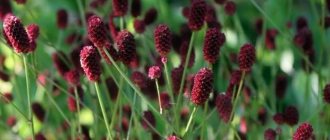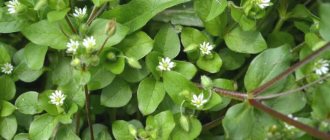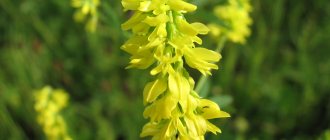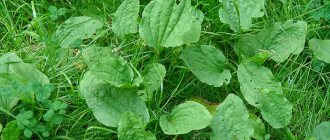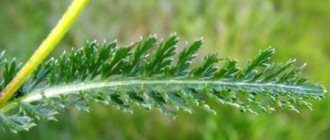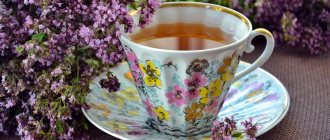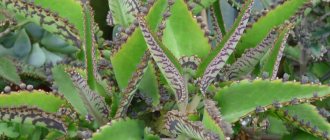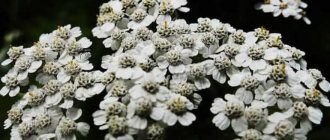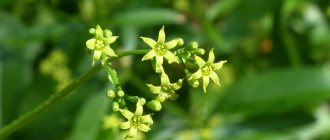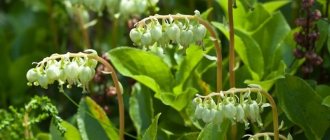Common mantle (lat. Alchemilla vulgaris) is a perennial herbaceous plant of the Rosaceae family. Its other names are bear's paw, woman's grass, heavenly dew, god's tear, breastfeeding, dewberry, eyelash, rue, etc. The herb is known for its anti-inflammatory, antibacterial and hemostatic effects. It is used in official and folk medicine to treat gynecological problems, gastrointestinal diseases, tuberculosis, obesity and other pathological conditions.
What kind of grass is mantle, what does it look like and where does it grow?
Mantle grass grows in North America, Asia, East Africa, Europe, the CIS countries, Siberia - in meadows, forest edges, forests and along roads.
photo of a plant in its natural habitat
The botanical description is characterized by the following features:
The root of the cuff is thick and strong with numerous branches. The stem reaches 40 cm, branched, creeping. The leaves of the cuff have a rich green color, palmate-lobed structure and a round shape with frills. Dew accumulates in the middle of the leaf, for which the cuff is nicknamed the tear of God. The plant blooms all summer, and under favorable conditions it can bloom twice per season. The flowers are inconspicuous, small, greenish-yellow, collected in an inflorescence - false umbrellas. Forms fruits - nuts with cups. Propagated by seeds and vegetatively.
About 40 species of the plant are known, but only the sparkling cuff and the common cuff, which have general healing abilities, are used in medicine.
Composition of grass cuff
The cuff, the medicinal properties and contraindications of which are determined by the chemical composition, is rich in the following biologically active components;
- Phytosterols;
- Ascorbic acid;
- Phenolcarboxylic acids;
- Lignins;
- Tannins;
- Flavonoids;
- Fatty acids;
- Coumarins;
- Lipids;
- Leukoanthocyanidins;
- Bitters, resins;
- Kakheti;
- Minerals (iron, boron, copper, manganese, zinc, molybdenum, nickel).
For harvesting, the plant can be collected in the wild, or it can be grown at home
Description of the cuff
Content
Common mantle is a perennial herbaceous plant with an erect rhizome and the same leaves, on which venation is clearly visible. The maximum height to which the creeper grows is 40 cm, although when grown at home and creating a favorable climate for growth, it can reach 50-60 cm. In appearance, it is quite easy to distinguish it from other herbaceous plants, mainly by the inflorescence, located in the receptacle calyx. It was this characteristic feature that became the reason for the plant’s most famous name.
It evokes associations with a long ripped cuff from which a hand peeks out. The number of flowers in an inflorescence may vary, depending on the age and growing conditions, but in a good season the plant can bloom twice - in spring and autumn. The cuff plant produces a lot of small seeds, but their use for industrial purposes requires a long waiting period for the product, so in dachas and gardens it is planted using division. You can avoid waiting for the plant's second year if you plant its seeds in seedling boxes, as is done with other garden perennials.
To produce fruits that resemble a small nut, the sundew does not necessarily require fertilization; the mantle still goes through the process of forming the fruit, because this assumes its natural structure. The plant has been used in alternative medicine for centuries, and the reason for this is the rich natural composition that it accumulates in its segments.
The healing properties of the cuff
The benefit of the common cuff lies in its therapeutic effects:
- Stimulates the activity of the endocrine glands and the formation of hormones;
- Relieves inflammatory processes, eliminates bacterial infections, removes staphylococci, salmonella, fungi and ammonia from the body;
- Stops bleeding;
- Normalizes cardiovascular function, narrows blood vessels and improves their elasticity, reduces permeability and fragility of capillaries;
- Improves the functioning of the central nervous system;
- Increases physical and mental activity, strengthens the immune system;
- Normalizes the functioning of the stomach and intestines, eliminates the symptoms of poisoning with poisons and heavy metals;
- Regulates mineral metabolism, improves metabolism, accelerates the process of energy formation;
- Stimulates the functioning of the kidneys and liver, accelerates bile formation and its removal from the body;
- Normalizes hematopoiesis, improves the process of iron absorption, which prevents the occurrence of anemia;
- Neutralizes the destructive effect of free radicals, providing an anti-sclerotic effect and preventing the process of premature aging of the body.
The cuff has an astringent, wound-healing, immunostimulating, anti-inflammatory, detoxifying, antioxidant, enterosorbing effect on the human body.
Contraindications and harm of the cuff
If there are no medical restrictions on taking the cuff, then this plant is a safe remedy approved for use by adults and children. Contraindications are increased blood clotting and individual intolerance. In rare cases, a side effect such as diarrhea may occur.
with a cuff, various medical and homeopathic remedies are prepared for the treatment and prevention of various diseases
Homemade Cuff Remedies
Several folk remedies that can be prepared at home from cuff raw materials:
- Decoction: 8 teaspoons of dry leaves should be poured into two glasses of boiling water, put on low heat and cook for 5 minutes, then cool and strain. The finished decoction is taken orally half a glass 2-3 times a day before meals for cough, fever, bleeding, or used externally to treat weeping eczema, acne, itchy wounds;
- Tincture: 5 g of mantle grass should be poured into 0.2 liters of dry red wine, left for 24 hours, then strained. The finished tincture is taken 1 tbsp. spoon 3 times a day to improve metabolism and eliminate heart pain;
- Tea: 4 teaspoons of crushed horseradish herb should be poured into 0.5 liters of boiling water, steeped for 10 minutes, then strained. Ready-made tea is taken orally warm, 1 glass no more than 3 times a day for insomnia, fever, and colds.
It is recommended to consult a doctor before using horseradish home remedies.
Pharmaceutical preparations with a common cuff
The common cuff is used in medicine, homeopathy, medicines are prepared on its basis, the plant is included in herbal preparations, balms and dietary supplements for the treatment and prevention of many diseases.
Common mantle grass is a dry raw material for preparing medicinal infusions and decoctions.
Elixir "Ginex" is a homeopathic medicine for the treatment of diseases of the stomach, spleen, pancreas, gynecological diseases, and hormonal imbalances.
“Gineconorm” is available in the form of herbal phytocapsules intended for the treatment of menstrual disorders, uterine fibroids, fibroids, cervical erosion, uterine bleeding, pyelonephritis, cystitis.
Compound
Knowing what a cuff looks like, they try to stock it up for future use in order to use it for medicinal purposes if necessary. The scope of application of the herb extends to many needs of the human body, from gynecological to metabolic disorders. It treats tuberculosis and dysbacteriosis, restores the female reproductive cycle, and relieves swelling and congestion in the respiratory organs. All these natural properties can be used thanks to the healing composition, in which clinical studies revealed:
- tannins, which make it possible to widely use the plant for skin lesions, diarrhea, tuberculosis and lung lesions, as well as for cosmetic purposes - to eliminate acne, rashes associated with metabolic or hormonal disorders;
- catechins and flavonoids, today – herbal remedies widely used in pharmacology to obtain an antiplatelet effect, optimize the state of venous and capillary networks in the body;
- phenolcarboxylic acids, in particular, necessary for some vital processes, phenolcarbon derivatives luteonic and ellagic, which are rarely found in nature, but may be important in disease states;
- lignin is a substance that determines the state of some cells (not only the herb is sold in pharmacies, but also lignin separately, as a medicine known for its ability to bind toxins and harmful substances in severe poisoning;
- lipids and coumarins, useful for anemia and general weakening of the body.
Listing what the cuff treats could take several pages, since due to its healing composition it can be useful for many conditions. The chemical components of the creeper have not been sufficiently studied. However, the benefits that treatment with a medicinal perennial plant can bring have been known for many centuries, and the modest-looking herb has been used since ancient civilizations.
Long sold as a pharmaceutical product prepared from industrially grown raw materials, it is especially widespread in Western European countries and in many Eastern and Southern countries. In the Russian Federation, the cuff has always been used for medicinal purposes by representatives of alternative medicine, but now it has become a widely used medical product. Preparations and raw materials from medicinal plants can always be purchased at retail pharmacy chains.
Don’t be shy, ask our consultants questions, right here on the website. We will definitely answer. Leave commentsGo
Traditional medicine recipes. Preparation of remedies and treatment. List of diseases
The beneficial properties and contraindications of the cuff allow it to be used in the treatment of pathological conditions:
- Gynecological diseases: inflammation, vaginitis, menopause, uterine bleeding.
- Digestive organs: gastrointestinal ulcers, peristalsis disorders, dyspepsia, inflammation of the liver and bile ducts, cholecystitis, colitis, enterocolitis, diarrhea.
- Respiratory organs: pneumonia, bronchitis, laryngitis, cough, tuberculosis.
- Urinary organs: cystitis, pyelonephritis, ascites.
- Metabolism: diabetes, obesity, gout.
- Cardiovascular system: atherosclerosis, hypertension, thrombophlebitis, varicose veins.
- Nervous system: neuroses, insomnia.
- Skin: eczema, wounds, burns, ulcers, acne, ulcers.
To treat these diseases, the cuff is used to prepare decoctions, infusions, tinctures and other medicinal products.
For the preparation of medicinal products, the above-ground part of the plant is used, which has the greatest medicinal effectiveness.
Infusions
The infusion relieves inflammation of the intestines and enhances its peristalsis, heals hemorrhoids, and accelerates the removal of mucus from the bronchi. A cuff is useful in gynecology - in case of heavy menstruation, bleeding, leucorrhoea, douching is performed. An infusion in the form of a compress removes inflammation of the eyes and treats a runny nose.
- boiling water in the amount of 250 ml. and 3 tsp. the herbs are placed in a warm place for two hours. Strain and drink 1/2 cup before meals up to 4 times a day or use for procedures.
Tinctures
Alcohol tincture is used to treat the urinary and digestive systems:
- 50 gr. The cuffs are added to half a liter of alcohol, sealed and placed in a warm and dark place to infuse, during which the contents are periodically shaken. After two weeks, filter and take a teaspoon before meals.
For heart pain and sluggish metabolism, prepare an infusion of red wine:
- 200 gr. dry red wine and 5 gr. combine herbs. Seal the container and place in a dark place for a day. Strain the finished infusion and drink 1 tbsp up to 3 times a day. l.
Decoctions
The decoction is used externally as an anti-inflammatory and wound-healing agent for weeping eczema, acne and itchy wounds. It is taken orally for bleeding and coughing as an antitussive and expectorant. The drink helps with rheumatism and gout.
- 2 tbsp. l. Place the leaves of the plant in a container with a glass of water and let it simmer for 5 minutes. Strain the cooled broth and drink 1/2 cup up to 3 times a day before meals.
Juice
The juice is squeezed from young stems and leaves. For diseases of the gastrointestinal tract, dysentery, diarrhea, take 1 tsp. up to 4 times a day.
leaves of the cuff are used in medical practice and in cooking
Leaves
Cuff leaves are rich in resinous substances, ascorbic acid, phytosterol and phytohormones, similar to female hormones. Therefore, it is recommended to use decoction and infusion with leaves to relieve the symptoms of menopause. The leaves contain less tannins (up to 2.5 mg), but more vitamin C (up to 200 mg). Therefore, young leaves are used in cooking to enrich dishes with vitamins and other useful substances. To do this, they need to be scalded with boiling water, cooled and used in preparing salads, vinaigrettes, and vegetable dishes. You can make a decoction of 5-6 leaves and a glass of boiling water and add it to compote or kvass in a ratio of 1:5.
Salad
A healing salad is prepared with the cuff, which replenishes the body with useful substances, has a therapeutic effect and a preventive effect against the occurrence of various diseases.
- Young leaves of the cuff are immersed in boiling water for a couple of minutes, the water is drained. Spinach, sorrel, onion, and dressing are added to the leaves.
Tea
The drink is useful for relieving an attack of menopausal syndrome and relieving pain during heavy menstruation. Tea with cuff normalizes the functioning of the stomach and intestines, improves metabolism, and is taken for weight loss. Helps with colds, fever, stress, insomnia, obesity.
- 2 tsp. cuffs and 250 ml. Leave boiling water for 10 minutes, then strain and drink up to 3 cups throughout the day.
tea with cuff has a wide range of therapeutic effects and is recommended for use by all categories of citizens
The benefits of tea with cuff for weight loss are explained by the warming effect, stimulation of blood circulation and metabolism, which promotes active weight loss.
Fees
The common cuff is included in medicinal herbal preparations that have a therapeutic effect for various diseases.
For diabetes: take flax seeds, mantle grass, juniper, blueberry leaves - all in equal proportions. 2 tbsp. l. The medicinal mixture is placed in a container with 1/2 liters. water. Keep on low heat for 10 minutes. Drink 10 ml of the infused and cooled decoction. twice a day.
For infertility: take mantle, black pepper, cinnamon bark, pepper knotweed in equal quantities. 1 tbsp. l. the collection is poured with a glass of boiling water, brought to a boil and simmered over low heat for 10 minutes. The cooled broth is drunk throughout the day.
For inflammation of the ovaries, vaginosis and vaginitis: take cuff and sage herbs in proportions of 3 and 1 tbsp. l, pour 1/2 l. boiling water, leave for 20 minutes. Take the infusion orally, one teaspoon at a time. three times a day and douching with warm infusion.
Grass cuff: application
The use of perennial herbs in alternative medicine is popular. Traditional healers use its natural remedies as a treatment for the digestive system and problems with the cardiovascular system, and are used for anemia and ulcers of the stomach and duodenum. The lignin contained in it makes it possible to recommend medicinal decoctions as a powerful detoxification agent, and bioflavonoids as a natural plant antioxidant and antiplatelet agent. The Central Botanical Garden, a branch of the Russian Academy of Sciences in Siberia, received patents from the Laboratory of Phytochemistry for the use of cuff preparations in the treatment of vascular pathologies. In this case, its restorative, regenerative, antioxidant and wound-healing properties are involved.
Cuff in gynecology
In gynecology, the range of uses of horseradish is unusually wide. It is used to treat pathologies of the mammary gland, endometriosis and dysmenorrhea, and is prescribed for excessive leucorrhoea and uterine bleeding. The cuff plant exhibits medicinal properties in gynecology for any disorders of the menstrual cycle, hypermenstrual syndrome, neoplasms and hemorrhoids. Much of the gynecological use is due to the herb's ability to regulate endocrine disorders. After all, they are, most often, the cause of dysfunction of the female reproductive system during the reproductive, pubertal and menopausal periods.
Cuff: diabetes mellitus
The main effect in diabetes is the restoration and normalization of hormonal levels, the disruption of which leads to the development of pathology. In a diabetic, the cuff optimizes the state of the vascular system, regulates metabolism, and prevents the development of atherosclerosis, which is a common consequence. The action of sundew also allows you to eliminate swelling, which is characteristic of many stages of the development of the disease.
Cuff during pregnancy
During pregnancy, sundew can prevent the threat of miscarriage, but this is not all of its beneficial properties. Used in the correct proportions, it stimulates the development of the fetus and prevents deviations, helps to cope with the manifestations of disorders of nervous activity (depression, irritability, aggressiveness) and prepares the body for the upcoming birth. After childbirth, medicinal herb will help stop heavy bleeding.
Weight loss
In losing weight, the main role is played by phenolcarboxylic acid, which is indispensable in normalizing vascular and metabolic activity. The cuff is also used to shed excess accumulations because of flavonoids - they help maintain cell tone and normalize the condition of the skin after weight loss.
Treatment for men
For men, the cuff is a good remedy for impotence. It eliminates inflammation and infectious lesions of the genitourinary system, restores reproductive function, treats prostatitis and urethritis. Therapeutic products with a cuff regulate cholesterol levels and strengthen blood vessels, which is very important for men, since they are more susceptible to cardiovascular diseases.
the herb has a beneficial effect on maintaining women's health and beauty
Is a cuff useful for everyone?
You will be surprised, but almost everyone without exception can use the cuff as a preventative or herbal medicine.
Particular attention should be paid to the component composition. In case of individual intolerance or hypersensitivity to one of the ingredients, allergic reactions may occur. Otherwise, the cuff is an absolutely safe herbal remedy.
On a note! The maximum permissible daily dosage and duration of treatment must be agreed with a specialist. Otherwise, disturbances in the functioning of the digestive tract may appear in the form of diarrhea or constipation.
Treatment of women
If a woman has health problems in the gynecological area, the cuff gives a good therapeutic effect. The phytohormones contained in the plant can normalize hormonal levels, alleviate menopause and have a therapeutic effect in case of infertility. To treat inflammation of the uterus, erosions and leucorrhoea, a herbal decoction is prepared:
- mantle, hogweed, burnet root and bergenia (in proportions 3:1:1:1). 2 tbsp. l. Place the mixture in half a liter of water, bring to a boil and simmer over low heat for 3 minutes. Leave for an hour and strain. Use the product warm for douching up to 2 times a day. The course of procedures is 10 days (not during menstruation). The duration of therapy is from 2 to 6 months, but consultation with a doctor is necessary.
The cuff during pregnancy is approved for use from the 14th week. It helps prepare the mother's body for childbirth and reduces nervous excitability. The expectant mother can drink tea from the cuff; the drink helps with the incorrect location of the placenta and the threat of miscarriage. After childbirth, the cuff stops bleeding and helps increase breast milk production.
Collection, preparation, storage of cuffs
You can start collecting the green part of the grass at the end of May and until the end of September. Some traditional healers also use the roots of the plant, which can be dug up at the end of September.
It is better to collect in the daytime after the dew has dried on the branches of the plant. The entire above-ground part is cut off, and the roots are dug out with a shovel. The green part must be sorted out well, and any spoiled leaves and twigs must be discarded. Wash the roots to remove dirt.
The grass can be hung in bunches or laid out on a flat surface in a dark place. To speed up the process, it is recommended to use electric dryers.
The roots are laid out in an even layer in a dark place, preferably in the attic under a metal roof. For good drying of the grass and roots, in addition to heat, you also need good ventilation, otherwise all the raw materials will simply become damp.
We recommend reading: Medicinal properties and contraindications of boron uterus, how to take it
After drying, place all raw materials in cotton bags. The herb is stored for about a year, then it begins to taste bitter. Should be stored in a dry, well-ventilated place.
Cuff in cooking
The cuff is eaten; young shoots and leaves are used for this purpose. They prepare salads, cabbage soup, and soups. For the winter, powder is prepared from the cuff for seasoning second and first courses. The plant is pickled with other herbs, as well as vegetables. The taste of the cuff is slightly tart and bitter. The flowers of the plant are crushed and used to prepare a variety of pastes and spreads for sandwiches.
the beautiful decorative appearance of the cuff allows it to be used in decorating parks and gardens
Component composition
There are several varieties of this perennial plant, and all of them are popular in official and alternative medicine. What value does the cuff sparkling have for human health? Its medicinal properties are directly related to its component composition.
The cuff is enriched with the following elements:
- steroids;
- phenolcarboxylic acids;
- vitamin C;
- lignin;
- tannins;
- flavonoids;
- lipids;
- coumarins;
- catechins, etc.
If we consider each component separately, it gives the human body incredible benefits. Thus, steroids have a beneficial effect on the human immune system, helping to strengthen it. And acids have antiseptic and choleretic properties.
As for vitamin C, it is simply indispensable for the nervous and immune systems. In addition, with the help of ascorbic acid, the functioning of the endocrine system is normalized. The remaining elements have general strengthening and cleansing properties.
On a note! The common mantle grows mainly in swampy, forest and meadow areas. The beneficial properties of the plant, regardless of the variety, will be identical. By the way, the herbal remedy got its name thanks to its curly leaves, reminiscent of a carved cap cuff. And in ancient times, alchemists believed that a philosopher's stone could be made from a cuff.
